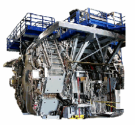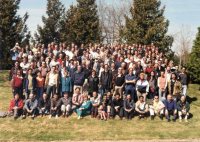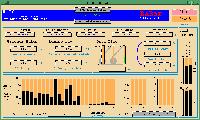 Skip to Content
Skip to ContentWELCOME About HEP
Research
Graduate Studies
Theses
Employment
Contact Info
HEP GROUP
Personnel
Computing
Media Releases
Events
Links

The Babar Group at UVic |

The BaBar experiment is designed to study how the laws of physics differ for ordinary matter and anti-matter. It was believed until 1964 that the laws of physics were the identical for matter and anti-matter; more technically, that all interactions were invariant under the combined symmetry operation CP (C=charge conjugation, P=parity). This belief was shattered in a famous experiment by Cronin and Fitch, in which it was shown that CP was violated at a part per thousand in the neutral K meson system. For the next 35 years we had been unable to measure CP violation in any other system, making it impossible to test the theory describing this phenomena. 
BaBar recorded its first e+e- collision data in May, 1999 and as of October, 2003 has accumulated over 120 million B-Bbar events. The performance of the PEP-II accelerator has been excellent, reaching the design luminosity in the first full year of operation and exceeding design by more than a factor of two. BaBar published the first definitive observation that CP is violated in B meson decays in July, 2001: "Observation of CP violation in the B^0 meson System" , PRL 87, 091801 (2001). 
The University of Victoria has a large and active group on BaBar. We collaborated with Canadian, Italian, and U.S. institutions on the construction and quality control of the BaBar drift chamber. The drift chamber, the primary BaBar detector for measuring charged particle trajectories, was built at TRIUMF and was installed in the BaBar experiment during 1998. The chamber provides the primary momentum measurement and ionization energy loss (dE/dx) measurement for charged particles in BaBar. The main focus of our effort is on analyzing BaBar data and producing physics results. Our group contributes heavily in the analysis of semileptonic B meson decays and in studies of the tau lepton, where members of our group are convenors of BaBar-wide analysis working groups. We have significant computing resources in Victoria (two Linux clusters and tens of terabytes of storage) that are used for data analysis and for producing simulated event samples for use by the BaBar collaboration. 
Victoria has contributed to the online control software (written in EPICS), the operation of the Drift chamber gas system, the tracking reconstruction software, the dE/dx calibration and central data analysis software. Members of our group have served as Run Manager (in charge of daily BaBar data taking operations) and as members of the Executive Board and the Publications Board. BaBar will continue to be a forefront experiment for several more years. Our group welcomes applications from prospective graduate students at the M.Sc. and Ph.D. level. Please see the PHAST grad application page for more information. |